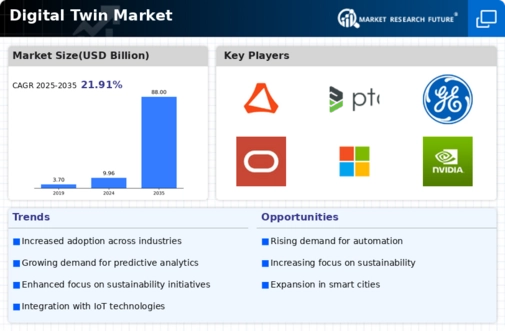Market Growth Projections
The Global Digital Twin Market Industry is projected to experience substantial growth, with estimates indicating a rise from 9.96 USD Billion in 2024 to 88.0 USD Billion by 2035. This growth trajectory suggests a compound annual growth rate (CAGR) of 21.91% from 2025 to 2035. Such projections reflect the increasing recognition of digital twins as a transformative technology across various sectors, including manufacturing, healthcare, and urban planning. The anticipated market expansion underscores the potential for digital twin solutions to enhance operational efficiency and drive innovation in the coming years.
Growing Demand for Smart Cities
The global push towards smart city initiatives appears to significantly influence the Global Digital Twin Market Industry. Digital twins facilitate urban planning and management by simulating city infrastructure and services. This technology allows city planners to analyze traffic patterns, energy consumption, and resource allocation effectively. For instance, cities like Singapore utilize digital twins to enhance urban mobility and sustainability. As governments and municipalities invest in smart city projects, the demand for digital twin solutions is likely to increase, supporting the market's projected CAGR of 21.91% from 2025 to 2035.
Rising Adoption of IoT Technologies
The integration of Internet of Things (IoT) technologies into various sectors appears to drive the Global Digital Twin Market Industry. As organizations increasingly adopt IoT devices, they generate vast amounts of data that can be utilized to create digital twins. This technology enables real-time monitoring and predictive analytics, enhancing operational efficiency. For instance, in manufacturing, companies leverage digital twins to optimize production processes, leading to reduced downtime and improved resource allocation. With the market projected to reach 9.96 USD Billion in 2024, the growing reliance on IoT is likely to propel the digital twin adoption further.
Advancements in Simulation Technologies
Technological advancements in simulation and modeling tools seem to be propelling the Global Digital Twin Market Industry forward. Enhanced computational power and sophisticated algorithms enable the creation of highly accurate digital twins that can replicate real-world systems. Industries such as automotive and healthcare are increasingly adopting these advanced simulations to improve product design and patient outcomes. For example, automotive manufacturers use digital twins to test vehicle performance under various conditions, leading to safer and more efficient designs. As simulation technologies continue to evolve, they are likely to drive further growth in the digital twin market.
Increased Focus on Predictive Maintenance
The emphasis on predictive maintenance across industries seems to be a key driver for the Global Digital Twin Market Industry. By utilizing digital twins, organizations can simulate equipment behavior and predict potential failures before they occur. This proactive approach minimizes unplanned downtime and maintenance costs. For example, in the aerospace sector, companies employ digital twins to monitor aircraft performance, thereby enhancing safety and reducing operational costs. As industries recognize the financial benefits of predictive maintenance, the demand for digital twin solutions is expected to surge, contributing to the market's anticipated growth to 88.0 USD Billion by 2035.
Regulatory Compliance and Risk Management
The need for regulatory compliance and effective risk management appears to be a significant driver for the Global Digital Twin Market Industry. Organizations across sectors are increasingly required to adhere to stringent regulations regarding safety, quality, and environmental impact. Digital twins provide a means to simulate and analyze compliance scenarios, enabling companies to identify potential risks and mitigate them proactively. For instance, in the energy sector, digital twins are used to ensure compliance with environmental regulations while optimizing resource usage. As regulatory pressures mount, the adoption of digital twin technology is likely to rise.

























Leave a Comment